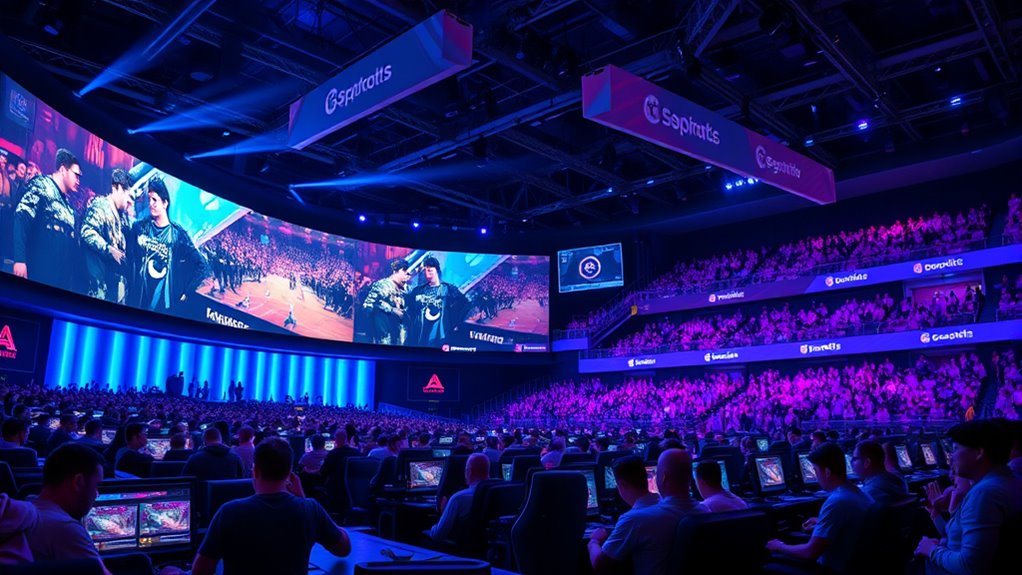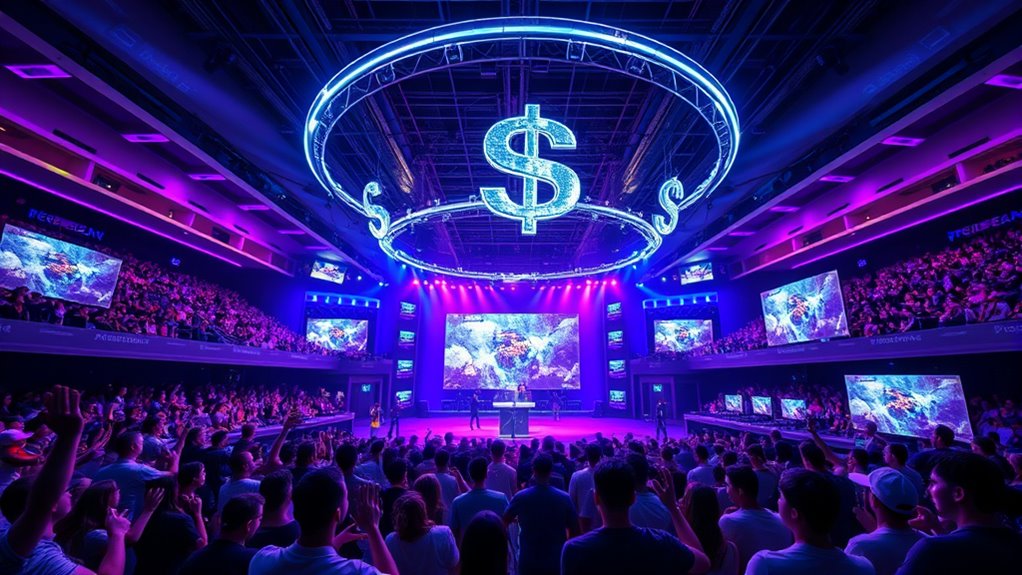You can see that the economics of global esports leagues rely heavily on sponsorships and media rights, which are key revenue sources. Sponsorships go beyond logo placements, involving integrated campaigns and exclusive activations that attract digital-native audiences. Media deals with broadcasters and streaming platforms also boost income and content quality. Revenue sharing among organizers, teams, and players impacts competitive balance and long-term growth. Keep exploring to understand how these elements work together to drive the industry forward.
Key Takeaways
- Sponsorships are crucial for funding, offering brand integration, activations, and driving revenue growth for esports leagues.
- Media rights deals significantly boost revenues, with broadcasters and streaming platforms paying for exclusive coverage.
- Revenue sharing models influence competitive balance, incentivizing performance and investment among teams and players.
- Diverse revenue streams include sponsorships, media rights, ticket sales, merchandise, and in-game purchases, supporting league sustainability.
- Transparent revenue distribution fosters a healthy esports ecosystem, encouraging ongoing investment and global industry growth.

The economics of global esports leagues have rapidly evolved into a complex and lucrative industry, drawing widespread attention from investors, advertisers, and fans alike. As a participant in this ecosystem, you’ll notice that sponsorship opportunities play a vital role in shaping the league’s financial landscape. Companies see esports as a prime platform to reach a highly engaged, digital-native audience, leading to a surge in sponsorship deals. These partnerships aren’t just about logo placements; they involve integrated campaigns, branded content, and exclusive activations that considerably boost revenue. The influx of sponsorship dollars fuels the growth of leagues, allowing organizers to invest in better production, prize pools, and talent development, creating a cycle that attracts even more sponsors.
Understanding revenue distribution is essential if you’re interested in how the money flows within these leagues. Typically, revenue comes from multiple streams: sponsorships, media rights, ticket sales, merchandise, and in-game purchases. Among these, sponsorships often constitute a substantial portion, especially for top-tier leagues and events. The way this revenue is distributed varies but generally follows a model where a large share goes to league organizers, teams, and players. For example, league organizers might allocate funds for operational costs and marketing efforts, while teams receive a cut based on their performance, market size, or existing contracts. Players, in turn, earn from salaries, prize winnings, and sponsorships, which are often negotiated individually or through team agreements. Additionally, understanding diversification strategies can help leagues and stakeholders manage financial risks more effectively.
The distribution of revenue impacts the competitive balance and overall growth of the league. When a larger portion of sponsorship income is shared with teams and players, it incentivizes higher performance and investment at the team level. Conversely, if the revenue is concentrated among league organizers or a few dominant teams, it can create disparities that influence the ecosystem’s sustainability. As you follow the financial flows, you’ll see that transparent and fair revenue sharing models are essential to maintaining a healthy, competitive environment.
Moreover, the ongoing expansion of media rights deals amplifies the importance of sponsorship opportunities and revenue distribution. Major broadcasters and streaming platforms pay hefty sums for exclusive coverage, further increasing the league’s revenue pool. These deals often include provisions for sponsorship integrations, which bolster earnings for all involved. For you, as a fan or stakeholder, this means more high-quality content, better production values, and a more vibrant esports scene. By understanding how sponsorship opportunities align with revenue sharing, you get a clearer picture of how esports leagues sustain their growth and attract continuous investment, ensuring the industry remains dynamic and profitable.
Frequently Asked Questions
How Do Esports Leagues Generate Most of Their Revenue?
You might wonder how esports leagues make most of their money. They primarily generate revenue through sponsorship deals, where brands pay to promote their products during events and on teams’ gear. Merchandise sales also contribute considerably, as fans buy jerseys, accessories, and other branded items. These sources together form the backbone of esports league income, supporting players, events, and the growth of the industry overall.
What Are the Biggest Challenges Faced by Global Esports Leagues?
Imagine steering a stormy sea—you face sponsorship challenges and regulatory hurdles that threaten your voyage. For global esports leagues, these obstacles are real. Sponsorship deals can be unpredictable, and strict regulations vary across regions, making consistency tough. You must adapt quickly, build strong relationships, and stay compliant to succeed. Overcoming these challenges requires resilience, strategic planning, and a keen understanding of diverse markets.
How Do Esports Leagues Impact Local Economies?
Esports leagues boost local economies by attracting fans, increasing tourism, and encouraging spending. You’ll notice more Esports sponsorships coming in, which supports local businesses and promotes community engagement. Additionally, these leagues create local employment opportunities, from event staff to marketing roles. As a result, your area benefits from increased revenue and a stronger reputation in the gaming world, fostering long-term economic growth.
What Are the Key Factors Influencing League Profitability?
You should focus on sponsorship strategies and league expansion to boost profitability. Effective sponsorships bring in steady revenue and enhance your league’s visibility, while expanding into new markets attracts more fans and advertisers. Balancing these factors guarantees sustainable growth. You also need to manage costs, build a strong brand, and engage your audience consistently. By doing so, you’ll improve your league’s profitability and long-term success in the competitive esports landscape.
How Does Viewer Engagement Affect Esports League Economics?
Think of viewer engagement as the heartbeat of esports leagues. When your fan loyalty beats strong and viewership metrics rise, the league’s pulse quickens, attracting sponsors and advertisers. Your active participation fuels this rhythm, boosting revenue streams and increasing league profitability. The more you tune in and cheer, the more the league thrives, turning your passion into a powerful engine that drives the entire esports economy forward.
Conclusion
As you consider the booming world of global esports, remember that the industry generated over $1.1 billion in 2023 alone. This staggering figure highlights just how quickly the scene is growing and how much money is flowing into it. With millions tuning in worldwide, esports isn’t just a game — it’s a major economic force. So, as you watch the next match, know you’re witnessing a billion-dollar industry in action, shaping entertainment and commerce alike.









